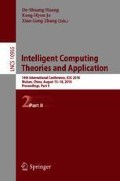Abstract
Protein structure prediction has always been an important issue in bioinformatics field. This paper proposes an HP model optimization method based on reinforcement learning, which is a new attempt in the area of protein structure prediction. It does not require external supervision as the agent can find the optimal solution from the reward function in the training process. And the method also decreases computational complexity through making the time complexity of the algorithm has a linear relationship with the length of protein sequence.
Access this chapter
Tax calculation will be finalised at checkout
Purchases are for personal use only
References
Yan, S.M., Wu, G.: Detailed folding structures of M-lycotoxin-Hc1a and its mutageneses using 2D HP model. Mol. Simul. 38(10), 809–822 (2012)
Pan, J., Wang, X., Cheng, Y., et al.: Multi-source transfer ELM-based Q learning. Neurocomputing 137(11), 57–64 (2014)
Mann, M., Backofen, R.: Exact methods for lattice protein models. Bio-Algorithms Med-Syst. 10(4), 213–225 (2014)
Tang, X., Wang, J., Zhong, J., et al.: Predicting essential proteins based on weighted degree centrality. IEEE/ACM Trans. Comput. Biol. Bioinform. 11(2), 407–418 (2014)
Qin, Y.F., Zheng, X.Q., Wang, J., et al.: Prediction of protein structural class based on linear predictive coding of PSI-BLAST profiles. Open Life Sci. 1, 11–15 (2015)
Huang, J.T., Wang, T., Huang, S.R., et al.: Prediction of protein folding rates from simplified secondary structure alphabet. J. Theor. Biol. 383, 1–6 (2015)
Acknowledgement
This paper is supported by the National Natural Science Foundation of China (61772357, 61502329, 61672371), Jiangsu 333 talent project and top six talent peak project (DZXX-010), Suzhou Foresight Research Project (SYG201704, SNG201610) and the Postgraduate Research & Practice Innovation Program of Jiangsu Province (SJCX17_0680).
Author information
Authors and Affiliations
Corresponding authors
Editor information
Editors and Affiliations
Rights and permissions
Copyright information
© 2018 Springer International Publishing AG, part of Springer Nature
About this paper
Cite this paper
Yang, R., Wu, H., Fu, Q., Ding, T., Chen, C. (2018). Optimizing HP Model Using Reinforcement Learning. In: Huang, DS., Jo, KH., Zhang, XL. (eds) Intelligent Computing Theories and Application. ICIC 2018. Lecture Notes in Computer Science(), vol 10955. Springer, Cham. https://doi.org/10.1007/978-3-319-95933-7_46
Download citation
DOI: https://doi.org/10.1007/978-3-319-95933-7_46
Published:
Publisher Name: Springer, Cham
Print ISBN: 978-3-319-95932-0
Online ISBN: 978-3-319-95933-7
eBook Packages: Computer ScienceComputer Science (R0)

